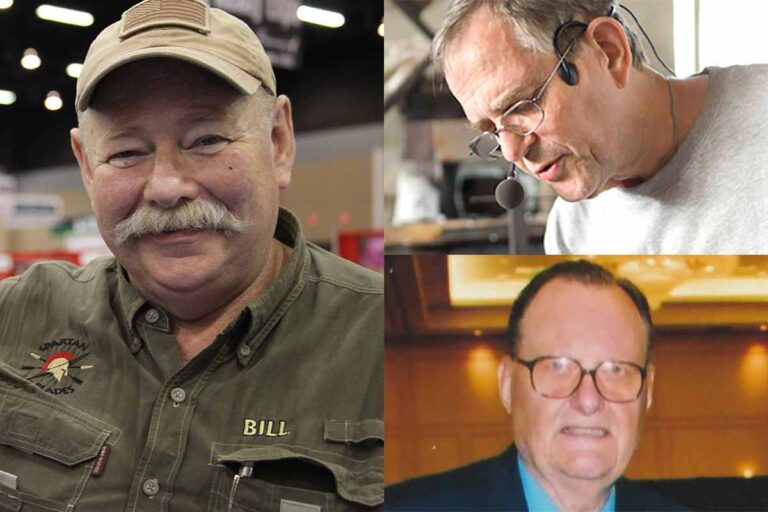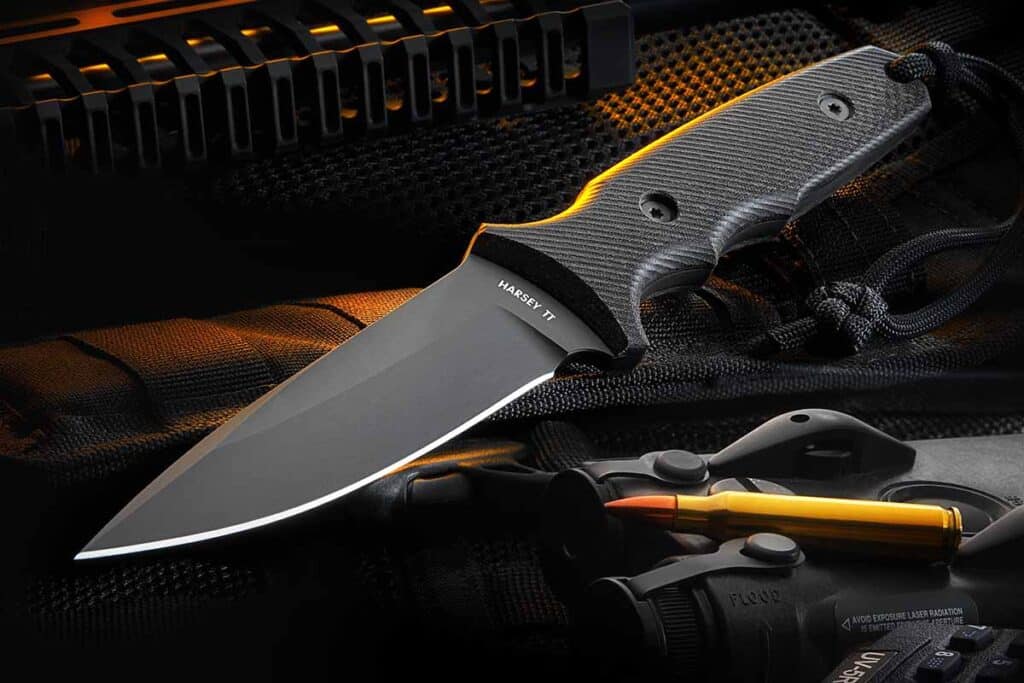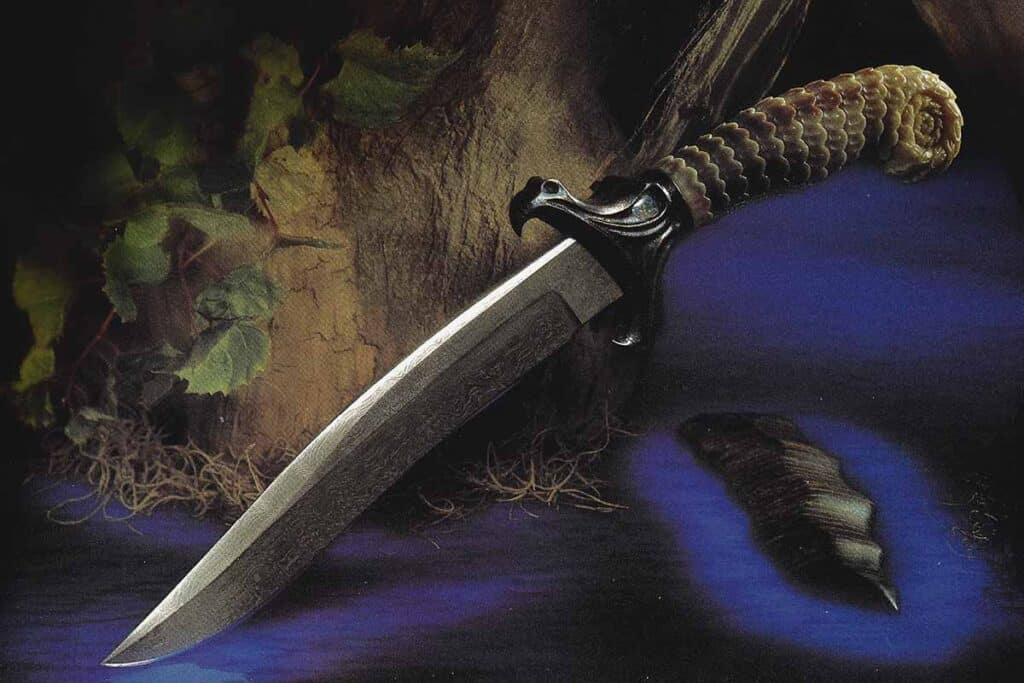
Cutlery Hall of Fame enshrines three icons of cut in Atlanta.
The BLADE Magazine Cutlery Hall of Fame® brought three groundbreakers of the world of knives into the fold June 7 with the formal inductions of premier knifemakers Ted Dowell and Bill Harsey and ABS master smith Don Fogg.
About 75 patrons were on hand for the breakfast/induction ceremony held in the Kennesaw Room of the Renaissance Atlanta Waverly Hotel the Saturday morning of BLADE Show 2024. For the first time in recent memory for the Hall-of-Fame ceremony, none of the inductees were on hand. Fogg and Harsey were unable to attend for health reasons, while Dowell passed away in 2012.
However, somehow it didn’t seem to matter so much as friends, family and acquaintances of the inductees and others took up the slack to produce a memorable induction event. Present to formally induct the new Cutlery Hall of Famers were Jeff Dowell (his father, Ted); Anne and Tim Reeve of Chris Reeve Knives and Curtis Iovito of Spartan Blades (Harsey); and Cutlery Hall-of-Famer Steve Schwarzer (Fogg).
T.M. “Ted” Dowell

As a founding member of The Knifemakers’ Guild, Ted Dowell played a key role in helping to organize the Guild, the grandaddy of all modern knifemaker organizations, in 1970. Along with fellow Cutlery Hall-Of-Famer Bob Loveless, he wrote the Guild’s original bylaws.
A veteran of the United States Navy, Ted resigned his position as a full-time mathematics professor in 1974 to go full time making knives. As Guild president in 1975, overcoming opposition from some in the Guild’s ranks, he coordinated the organization’s first custom-knives-only-no-guns show. He also helped Cutlery Hall-Of-Famer Phil Lobred establish the Art Knife Invitational in the early 1980s. Lobred credited Dowell with making the first modern integral knife, a design Ted introduced in 1972 in his basic hunters and which eventually evolved into some of the most ornate of integral art knives. Integral knives became a category of their own and remain popular to this day.
As Jeff noted, his father was passionate about the Guild and “all the foundations that set the pace and the tone for a lot of us that sit here today and reaped those rewards.” Jeff said much of the credit for his father’s success was due to the support of Mrs. Betty Dowell, who, while unable to attend the induction ceremony, was there vicariously through her son.
“Mom had her 93rd birthday a couple of days ago,” Jeff said to cheers and applause from those in attendance, “and she’s doing pretty well for 93. She still lives in the house that she and Dad bought in 1962 in Bend, Oregon, and the shop is still in the backyard. It’s not as completely outfitted as much as it was when he was working but a lot of the core stuff is still there. I go out there and tinker around quite often, and his presence is still very much there.”

Jeff and his brother, Scott, worked in the shop making sheaths for their father’s knives before tragedy struck in 1975 when Scott was killed in a car accident. He was only 19. “That was a tough day,” Jeff recalled, “and it took both my dad and mom a while to recover.” Jeff soon assumed the sheath-making duties and Ted and Betty soldiered on with life, with Betty taking more of a lead role than ever.
“My mom was galvanized and determined to have a family to take care of and a household to run,” Jeff said, “and she ran every bit of the business. [Dad made the knives] but everything else she did. She attended to every detail of the business. She had two kids to take care of and she had a grieving husband and a knifemaker and a business to support, and she did so for another 40 years.”
Meanwhile, Ted continued to establish a reputation as one of the finest makers of custom knives. “During that time Dad produced some great hunting knives and was best known for his integral designs and Funny Folders and those types of things,” Jeff remembered. “It was really Phil Lobred that pushed him and got him into art knives, and Dad produced some absolutely stunning art knives over the years.” Many of those images are on the impressive tmdknives.com website for which Jeff provides updates when warranted.
Still, Jeff said, his mother loomed large in every knife her husband made. “I don’t know that Dad could have made all those knives if not for her,” he noted. “She was that influential and resolute in seeing this through. I was fortunate enough to be a big part in working in the shop before heading off to college, and I visited quite often during that time to see some of the great knives Dad was doing. They both felt he deserved to be in the Hall of Fame and it’s wonderful that he finally is.
“I thank everybody here who voted him in and the other inductees as well. It’s a great honor.”
William “Bill” Harsey, Jr.

Bill Harsey has made and designed knives for 38 years, during which time he has been one of the most prolific and recognizable names in the industry, working behind the scenes and designing for Al Mar Knives, Beretta, Chris Reeve Knives, CRKT, Gerber, Ruger and Spartan Blades. He worked and consulted with and designed for Cutlery Hall-Of-Famer Col. Rex Applegate, including the British SAS Collaboration Knife. Bill designed the U.S. Army Special Forces Green Beret Knife, aka The Yarborough, for Chris Reeve Knives, a serialized version of which was presented to each graduate of the Special Forces Qualification Course. He also designed the official knife of the Canadian Special Forces and the U.S. Navy SEAL Silver Trident knife, and worked on the Neil Roberts knife project.
A fourth-generation lumberjack, Bill was born into a family of lumberjacks that, as Anne Reeve put it, was kind of a working ranch. “His grandparents taught him the importance of a knife,” Anne read from notes Bill had prepared beforehand. “His grandfather taught him very much, including how to hand sharpen tools for work.”
As Anne noted, Special Forces soldiers guided Bill’s knife work from the beginning. Bill met and was advised by Cutlery Hall-of-Famer Al Mar, and they worked together on knife projects for many years. “Bill credited Al Mar with teaching him to recognize good design,” Anne noted. It was Mar, a Green Beret in his own right, who introduced Bill to Col. Applegate, and the two struck up a working relationship that lasted 14 years. Among the fruits of that relationship was the Applegate-Fairbairn combat knife for which, Cutlery Hall-of-Famer Bob Terzuola noted, Harsey did the prototypes and grinding of the blades.
Curtis Iovito explained how and why Bill fulfilled the requirements (see sidebar) for Hall-of-Fame membership. “In an industry where trust is paramount, Bill exemplifies honesty, character and integrity,” Curtis said, citing how Spartan Blades and Harsey consummated their numerous collaboration agreements. “Every deal we’ve done with Bill Harsey has been sealed with a handshake,” he said as Anne Reeve nodded in agreement. “People are just supposed to do things right,” Curtis observed. “Bill set a standard for ethical conduct in the knife industry.”

Demand in one’s area of expertise is almost always a sure sign of success, and the demand for Harsey’s design skill is high—not only domestically but internationally as well.
“He is an ambassador of American knives. His collaborations have transcended awards as demonstrated by the Special Ops community seeking his work throughout the world,” Curtis observed of the new inductee. “Through his contributions he has elevated the status of American knifemaking but also positive relationships around the world. [Spartan Blades] is located near Fort Bragg and I’ve had people from the Italian Special Forces, German Special Forces, GSG 9, and a plethora of others visiting Fort Bragg to call our shop and ask for Bill.
“Finally, I believe Bill is more than worthy because of his dedication to the craft. He sets the example for everyone else to follow and that reaches far beyond the U.S. border, which I find really cool, and in the relationships he builds. His legacy is one that’s shaped our industry and continues to inspire future generations of knifemakers.”
Donald L. Fogg

A United States Marine Corps veteran of the Vietnam War, Don Fogg long has shared his vast knowledge of steel and making knives and swords. He helped further the art of Samurai and Viking sword making and developed the W’s damascus pattern. He shared the drawings of his best gas forge and his gas heat treat oven for swords. He built one of the first 20-ton hydraulic forging presses for making damascus. Today the press is as popular as a power hammer. He also was instrumental in starting the American Bladesmith Society-sanctioned bladesmithing school in Auburn, Maine. In 2005, he won the BLADE Magazine Industry Achievement Award. In 2006, he was inducted into the ABS Hall of Fame.
Steve Schwarzer said Don is like the “original Yoda of bladesmithing” and is “a genius in the knife business.” The new inductee has been a guiding light of bladesmithing instruction, including teaching classes at the Bill Moran School of Bladesmithing, damascus and swordsmithing at the J.C. Campbell Folk School, and at Montgomery College, to name but a few. He has written many stories on bladesmithing that have been published in magazines and books worldwide. Steve said Don was one of the first to spread bladesmithing information on the Internet, including hosting an international chat group that flourished for years teaching and spreading the good word of the forged blade.
Like Harsey did for Anne Reeve, Don wrote a timeline of his career to help guide Schwarzer’s induction speech. Don’s “knifemaking adventure” started in 1976 when he met and befriended Jimmie Fikes, a master blacksmith who “really knew his stuff.” Don soon met Jim Schmidt and they gathered at Fikes’ shop to forge weld a damascus billet. “It became apparent if we were really going to grow we were going to have to expand the market and the number of people making blades,” Don wrote. Added Steve, “And that’s what Don did. He was one of the few knifemakers early on that approached it as a business.”
The Ashokan seminar in New York in 1980 was a pivotal moment that brought together the few leading smiths of the day, including Don, from all over the country. The hammer-in was a way of teaching and sharing knowledge that each smith had learned individually, exploding the growth of bladesmithing. “There’d been a lot of discussion about creating standards for the craft and a ratings system was developed,” Don wrote. Cutlery Hall-of-Famer Bill Moran, who together with Bill Bagwell, Don Hastings and Cutlery Hall-of-Famer B. R. Hughes formed the American Bladesmith Society in 1976, announced the first ABS master smith ratings at the 1982 New York Custom Knife Show. Fogg was one of those ABS master smiths.

Don’s main interest was steelwork, which soon exceeded his ability to make handles. Enter Murad Sayen, with the two forming the knifemaking team of Kemal. Don learned so much from Murad it opened his eyes creatively and he learned a whole new line of form, texture and contrast, which in turn changed his approach to making steel. One of their knives was pictured in the highly influential Esquire Magazine, which helped bring the beauty of art knives to the world outside the knife industry.
Don moved to Alabama, where he befriended Cutlery Hall-of-Famer Jim Batson. Fogg became a regular at Batson’s hammer-ins, sharing knowledge and also meeting bladesmith Chuck Patrick. Don and Chuck taught swordsmithing and worked together for years. In the interim Don dropped out of the ABS and lost his MS rating, but had grown and was “representing bladesmithing to the world.” With Batson’s encouragement he retook the MS test and passed it again.
“I feel privileged to have been at the beginning of what was to become a global rebirth of this ancient craft,” Don wrote. “I used to joke I have a well-developed set of archaic skills, but in truth I was so fortunate to have found my community and one that challenged me for my entire life and educated me in so many ways.”
Hall-of-Fame Requirements
To be inducted into the BLADE Magazine Cutlery Hall of Fame®, prospective members must have practiced all of the following during their careers:
- Demonstrated extraordinary service to the knife industry;
- Displayed honesty, character and integrity;
- Advanced the industry by the creativity and originality of their works or contributions;
- As ambassadors or outstanding contributors, have furthered the positive impact of the knife industry on the world at large, and;
- In summary, have demonstrated a worthiness to be a member of this prestigious group.
See Other Hall Of Fame Members:
- HENDRICKSON, IMELS JOIN CUTLERY HALL OF FAME®
- LORENZIS, RUPLE JOIN CUTLERY HALL OF FAME
- CUTLERY HALL OF FAME USHERS IN THOMAS, TERZUOLA AND SCHWARZER
- KEESLAR AND SORNBERGER JOIN CUTLERY HALL OF FAME®
 NEXT STEP: Download Your Free KNIFE GUIDE Issue of BLADE Magazine
NEXT STEP: Download Your Free KNIFE GUIDE Issue of BLADE Magazine
BLADE’s annual Knife Guide Issue features the newest knives and sharpeners, plus knife and axe reviews, knife sheaths, kit knives and a Knife Industry Directory.Get your FREE digital PDF instant download of the annual Knife Guide. No, really! We will email it to you right now when you subscribe to the BLADE email newsletter.






